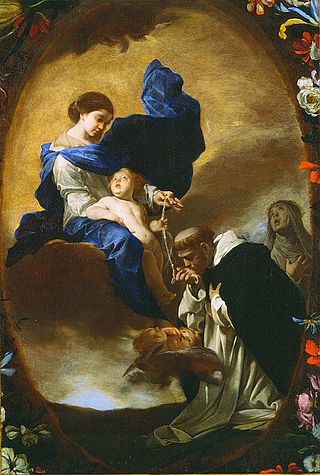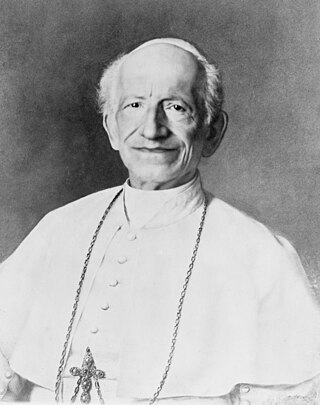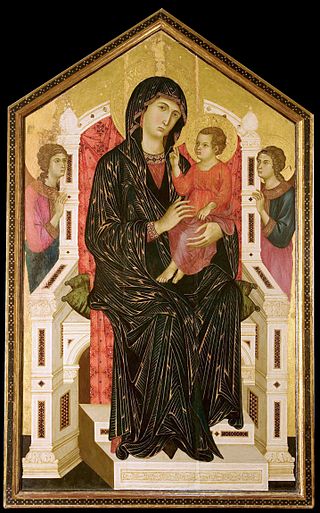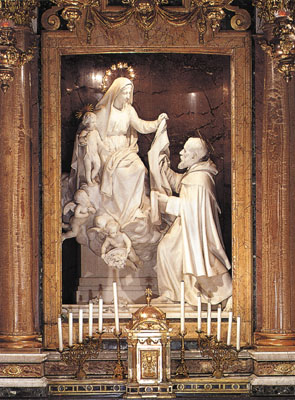Background
Octobri mense is the fifth of twelve encyclicals written by Leo XIII on the Rosary. Starting in 1883, all but two were issued in September in anticipation of October, the month dedicated to the Rosary. The subject of Octobri mense was the power of prayer and the efficacy of the rosary. [3]
"It is indeed a cause of great sorrow that so many should be deterred and led astray by error and enmity to God; that so many should be indifferent to all forms of religion, and should finally become estranged from faith; that so many Catholics should be such in name only, and should pay to religion no honour or worship." [4] Invoking Mary under the title Helper of Christians, Leo urges the faithful to have recourse to her.
"The Eternal Son of God [...] did not accomplish His design without adding there the free consent of the elect Mother, who represented in some sort all human kind, according to the illustrious and just opinion of St. Thomas, who says that the Annunciation was effected with the consent of the Virgin standing in the place of humanity."
St. Dominic’s devotion to the rosary is noted:
"the devotion was begun and spread abroad by the holy Patriarch Dominic as a most potent weapon against the enemies of the faith at an epoch not, indeed, unlike our own, of great danger to our holy religion. The heresy of the Albigenses had ...overrun many countries, and this most vile off spring of the Manicheans [...] There seemed to be no human hope of opposing this fanatical and most pernicious sect when timely succor came from on high through the instrument of Mary's Rosary. Thus under the favor of the powerful Virgin, the glorious vanquisher of all heresies" [6]
In every September for the next seven years following the writing of Octobri Mense in September 1891, Pope Leo XIII dedicated the month of October to the Rosary through the authorship of an encyclical.
These encyclicals continued the use of the Rosary by Leo as a rallying point against the evils in 1892, [7] 1893 [8] and 1894. [9]

The Rosary, formally known as the Psalter of Jesus and Mary, also known as the Dominican Rosary, refers to a set of prayers used primarily in the Catholic Church, and to the physical string of knots or beads used to count the component prayers. When referring to the prayer, the word is usually capitalized ; when referring to the prayer beads as an object, it is written with a lower-case initial letter.

Pope Leo XIII was head of the Catholic Church from 20 February 1878 until his death in July 1903. Living until the age of 93, he was the oldest pope whose age can be validated, and had the fourth-longest reign of any pope, behind those of Peter the Apostle, Pius IX and John Paul II.
Americanism was, in the years around 1900, a political and religious outlook attributed to some American Catholics and denounced as heresy by the Holy See.

Providentissimus Deus, "On the Study of Holy Scripture", was an encyclical letter issued by Pope Leo XIII on 18 November 1893. In it, he reviewed the history of Bible study from the time of the Church Fathers to the present, spoke against the errors of the Rationalists and "higher critics", and outlined principles of scripture study and guidelines for how scripture was to be taught in seminaries. He also addressed the issues of apparent contradictions between the Bible and physical science, or between one part of scripture and another, and how such apparent contradictions can be resolved.
The Nouvelle théologie is an intellectual movement in Catholic theology that arose in the mid-20th century. It is best known for Pope John XXIII's endorsement of its closely-associated ressourcement idea, which shaped the events of the Second Vatican Council. It existed most notably among certain circles of French and German theologians.

Rosarium Virginis Mariae is an apostolic letter by Pope John Paul II, issued on October 16, 2002, which declared from October 2002 to October 2003 as the "Year of the Rosary". It was published by Pope John Paul II in 2002 at the beginning of the twenty-fifth year of his pontificate.

Ad Caeli Reginam is an encyclical of Pope Pius XII, given at Rome, from St. Peter's Basilica, on the feast of the Maternity of the Blessed Virgin Mary, the eleventh day of October, 1954, towards the end of the Marian year, in the sixteenth year of his Pontificate. The encyclical is an important element of the Mariology of Pope Pius XII. It established the feast Queenship of Mary.

The Mariology of the popes is the theological study of the influence that the popes have had on the development, formulation and transformation of the Roman Catholic Church's doctrines and devotions relating to the Blessed Virgin Mary.

Mediatrix of all graces is a title that some in the Catholic Church give to the Blessed Virgin Mary; as the Mother of God, it includes the understanding that she mediates the Divine Grace. In addition to Mediatrix, other titles are given to her in the Church: Advocate, Helper, Benefactress. In a papal encyclical of 8 September 1894, Pope Leo XIII said: "The recourse we have to Mary in prayer follows upon the office she continuously fills by the side of the throne of God as Mediatrix of Divine grace."

Mariological papal documents have been a major force that has shaped Roman Catholic Mariology over the centuries. Mariology is developed by theologians on the basis not only of Scripture and Tradition but also of the sensus fidei of the faithful as a whole, "from the bishops to the last of the faithful", and papal documents have recorded those developments, defining Marian dogmas, spreading doctrines and encouraging devotions within the Catholic Church.

The exact origins of both the rosary and scapular are subject to debate among scholars. Pious tradition maintains that both the rosary and the brown Scapular of Our Lady of Mount Carmel were given by the Virgin Mary to Dominic and Simon Stock respectively during the 13th century. Historical records document their growth during the 16th and 17th centuries in Europe. By the early 20th century, they had gained such a strong following among Catholics worldwide that Josef Hilgers, writing in the Catholic Encyclopedia of 1914, stated: "Like the Rosary, the Brown scapular has become the badge of the devout Catholic."
Laetitiae sanctae is an encyclical on devotion to the rosary by Pope Leo XIII, known as the "Rosary Pope". It was issued on September 8, 1893 in Saint Peter's Basilica in Rome.
The rosary is one of the most notable features of popular Catholic spirituality. According to Pope John Paul II, rosary devotions are "among the finest and most praiseworthy traditions of Christian contemplation." From its origins in the twelfth century the rosary has been seen as a meditation on the life of Christ, and it is as such that many popes have approved of and encouraged its recitation.
Augustissimae Virginis Mariae is an encyclical by Pope Leo XIII. It was issued 12 September 1897 in Saint Peter's Basilica in Rome and encouraged faithful Catholics to enroll in the Confraternity of the Holy Rosary.
Divinum illud munus is an encyclical issued by Pope Leo XIII on May 9, 1897. In the encyclical, Leo addresses "the indwelling and miraculous power of the Holy Ghost; and the extent and efficiency of His action, both in the whole body of the Church and in the individual souls of its members, through the glorious abundance of His divine graces." As such it serves as one of the precursors to the Catholic pneumatological renaissance of the twentieth century.
Christi Matri is an encyclical by Pope Paul VI issued on 15 September 1966 to encourage the faithful to pray for peace by way of the customary special devotions during the month of October, traditionally dedicated in honor of the Most Blessed Virgin.
Supremi apostolatus officio, commonly referred to as "On Devotion of the Rosary", is the first of a number of encyclicals of Pope Leo XIII on the Rosary. It was issued on 1 September 1883, encouraging the practice.
The encyclical Magnae Dei Matris was issued on 8 September 1892. It is subtitled "The Rosary and Christian Life" and discusses the relation of the rosary to faith and morality.
Quod auctoritate is an encyclical published by Pope Leo XIII on 22 December 1885. It has the subtitle: "The Annunciation of an Extraordinary Holy Year", which coincided with the fiftieth anniversary of the pope's ordination.








